
home about us contact us subscribe

home about us contact us subscribe
|
|
|
|
Tastings: Biltmore Winery by Little & Associates
Asheville, North Carolina: A converted dairy barn regains its historic presence. by Kristen Richards March 14, 2002 In the late 1800’s, George
Washington Vanderbilt commissioned architect Richard Morris Hunt and landscape architect Frederick
Law Olmsted to design his
250-room chateau and 125,000-acre estate in Asheville, North Carolina. Today
(at only 5,000 acres) the Biltmore Estate
stands as the largest single residence in the United States. (Last year,
National Geographic Traveler named it one of the 50 “must-see” destinations and
one of 10 national wonders in America.) The Estate’s dairy barn was
enlarged and converted into the Biltmore Winery in the 1980’s. The conversion,
however good the intent, clouded the original features. Aesthetically, there
was no historical mystique or grandeur to tie it to its history or site. The
space needed to incorporate the “allure” and elevate the level of experience to
that of the main attraction – the Biltmore Mansion. Charlotte-based Little
& Associates Architects was commissioned to redesign the retail space and
the overall tour experience. A detailed survey of customers
and staff revealed elemental design challenges. Leading the list of concerns
was limited space – the shopping experience was rushed and cramped, and there
was no easy way to transport wines from storage to the sales floor for stocking
purposes. Added to that was the need to correct poor orientation and
circulation from the self-lead tour to the wine tasting to the retail area –
visitors were unclear about the flow. The design team’s most important
challenge was to resolve these concerns with respect to the winery’s interests
– that sales increase (per visitor) and that there be a significant return on
their investment. It was important to restore the winery according to some of
the basic historic architectural principles that had been compromised by
previous renovations. “The project sought to reintroduce clarity to the
original design, and return the building to some of the basic principles
established by Hunt," says project designer Jeffrey A. Kenoff, AIA. The existing architecture was
utilized as a precedent in the design of the new addition, and architectural
materials and details were re-used where appropriate. Wood arches in the
pavilion came from an arched dormer in an area clock tower. Many of the same
materials such as stucco, brick, and wood were incorporated into the addition.
Even the structural system and shape of the roof were replicated from the
original design. Stone pavers from the original courtyard were removed,
cleaned, and re-used as the tour patio flooring. Decorative windows and doors
were reclaimed and composed to form a new exterior wall. Demolished cedar shake
roofing and copper gutters were reused on the new entry portico. Smaller venues -- a premium
tasting counter, cooking demonstration area, general merchandising, tabletop
décor display, and a ten register cash wrap -- are uniquely expressed through
fixtures, lighting, and finishes. The final result is a design that balances
old and new construction. Through function, circulation, detail, and image, the
renovation sets the framework to celebrate the original design, and creates a
new perception of the wine on display – and for sale. A key indicator of the overall
success came when a visitor was overheard telling a staff member that the
renovations and addition “look as if they have always been there.” A team of architects, engineers,
interior designers, merchandising specialists, and construction cost
consultants made a winning combination. “The interactive and collaborative
process between the client and the design team not only fostered the project’s
success from a retailing standpoint, but also ensured its architectural impact
and importance,” says Steven Starr, Little & Associates’ Director of
Restaurant & Specialty Retail. The Biltmore Winery received an
AIA Honor Award in 2000, and was completed in May 2001. Size: 49,975 square feet (plus 4,000-square-foot addition) Little & Associates Design Team: Steven Starr (Director-in-Charge), Jeffrey Kenoff, AIA,
Wesley Stephens Electrical Engineer: Beacon
Engineering Mechanical/Plumbing
Engineer: R3 Engineering Structural Engineer:
Wright-Gibson Group Food Service Equipment
Consultant: Trimark-Foodcraft Construction Cost
Consultant: Richard Rutherford Associates Contractor: McCarroll
Construction, Inc Display Fixtures: Suss
Woodcraft Photographer: Don
Dubroff Photography (704-321-0410) Little & Associates, headquartered in
Charlotte, N.C., has offices in Dallas, Denver, Detroit, Los Angeles, Orlando,
Philadelphia, Research Triangle Park, NC, Silver Spring, MD, and Washington,
DC. The firm specializes in six industry sectors: Office, Community and
Education, Financial, Retail, Facilities Management, and Interior Architecture.
The firm’s range of services include Architecture, Engineering, Interior
Architecture, Land Planning, Graphic Design, Facility Management, Technology,
and Virtual Environments. |
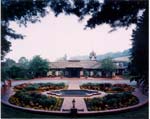 (Photo: Don Dubroff Photography) Approach to the Biltmore Winery.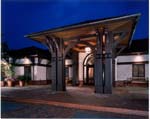 (Photo: Don Dubroff Photography) The Winery entrance.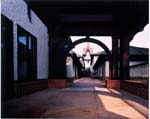 (Photo: Don Dubroff Photography) The patio and clock tower.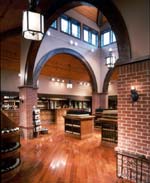 (Photo: Don Dubroff Photography) Wine retail displays.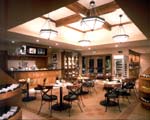 (Photo: Don Dubroff Photography) Food demonstration area.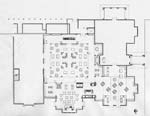 Floorplan Floorplan |
© 2002 ArchNewsNow.com